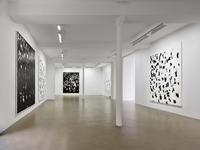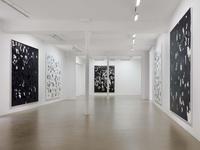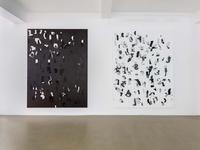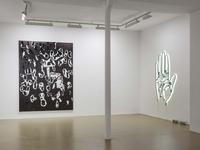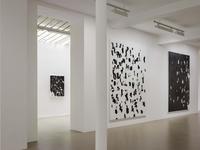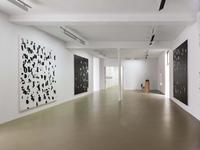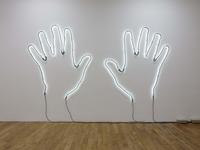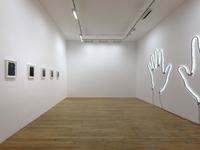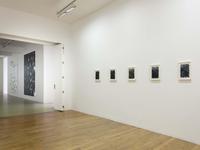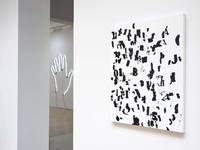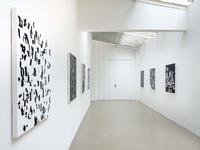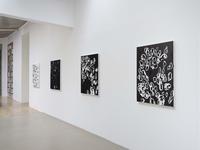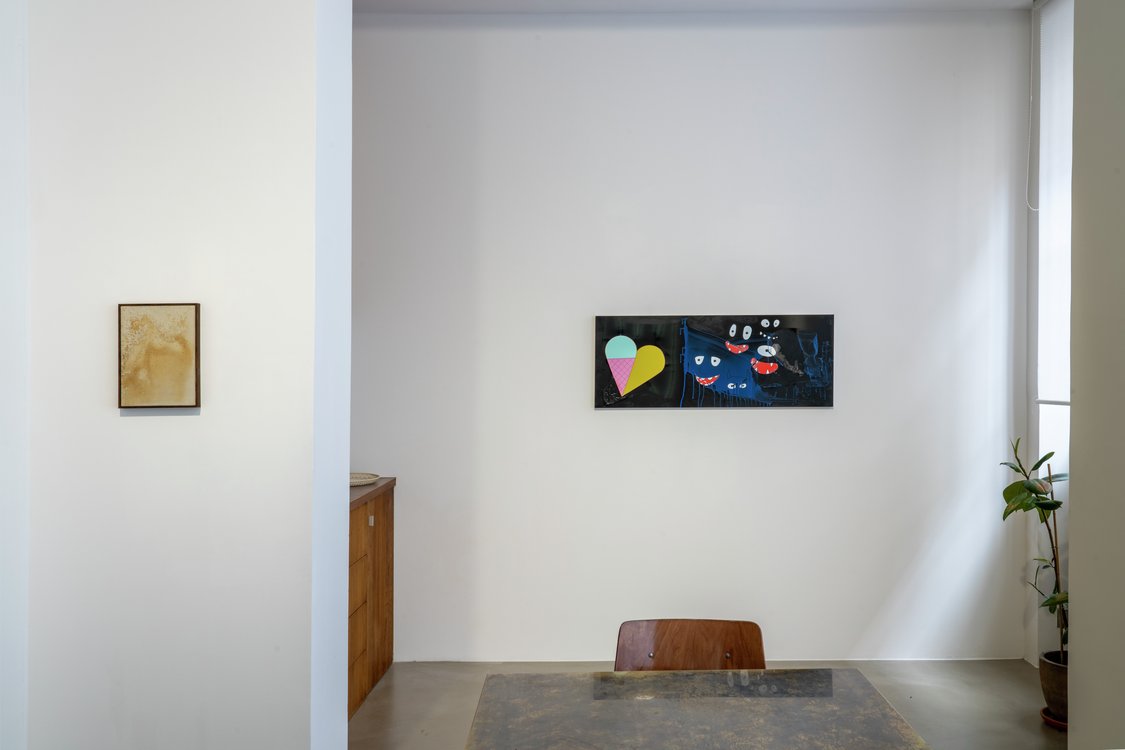For his first solo exhibition at Galerie Chantal Crousel, Glenn Ligon will present a new series of large and small silkscreen and ink marker paintings, based on abstracted letter forms; two figurative neon installations inspired by an uncompleted project of Pier Paolo Pasolini; ten oil stick and coal dust paintings on paper quoting a Gertrude Stein text.
Since the 1990s, Glenn Ligon has been exploring American history, literature and society by turning focusing on words, their meaning and illegibility. Relying on various literary sources such as texts by James Baldwin, Gertrude Stein, Walt Whitman or Jean Genet to name only a few, his approach gives palpable density and weight to the word.
With this new body of work presented in Paris, Ligon takes text to an even more abstract level.
A catalogue will accompany the exhibition, with an essay by Sara Nadal-Melsió, professor, writer, curator, poems by Gregg Bordowitz, artist, writer and scholar. It will be published in October 2018.
A panel talk with the artist and Sara Nadal-Melsió will take place at the gallery on September 11.
Glenn Ligon opened his studio to Sara Nadal-Melsió during the whole preparation of the show. As a result, the author explores Ligon's presented works relying on three ideas: improvisation, frontality, opacity.
Improvisation/Frontality/Opacity
by Sara Nadal-Melsió
Improvisation/Debris Field
Ligon’s Debris Field silkscreens can be read as anagrams for improvisational abstraction and speculation. While the word ‘debris’ seems to be stuck in the preterit tense of remnants and leftovers, witnesses to that which is no more, it also recalls the act of breaking down, of pulling something apart to see what is inside. The titles for the series, Study for Debris Field or Debris Fields allude to an open-ended exploration of unclear boundaries, markers of the prematurity of an improvisation that embraces that which is still unnamed and unfixed. Thus, it is not the open field of letters per se but the silkscreens as objects that are débris, leftover scores of an exercise in composition that appropriates the rhythms of musical improvisation to break language apart into pieces. It is as if Ligon had reached into the inside of language, into the pre-linguistic core that sustains it, to find a way out of its opacity through the flights of musical resonance; somehow having found sound’s musicality in his prolonged sounding of language’s depth.
Ligon’s commitment to the complexity of improvisation in his Debris Field paintings presents added difficulties. Characteristically, the materiality of his choice of medium and the reductive abstraction inherent to the linguistic are problems embedded in the silkscreens’ surfaces. The problems posed by musical and linguistic abstraction in their notational systems are of a different order and cannot be reduced to a simple effacement of orality and sound. Nevertheless, Ligon’s creative appropriation of dislocation and dispersal is formalized into an anagrammatic rhythm that blurs the two. The improvisations in Debris Field exhibit a sensibility towards the edges of words, the sites of their separation, of that which lies at the core of its abstraction and impersonality.
The starting point of all the silkscreens in the series is identical, the instruments at play do not change, yet the outcome is always strikingly different. Improvisation becomes a system capable of generating multiple outcomes that cannot be interchanged but are united in their associative difference, as clusters of graphic utterances of the singular, as zones of intensity. The field of the silkscreen is speculative and multiple, the boundary is no longer exterior, as in the canvas or the textual quotation, but in the separation of one letter from another, in the letter’s edge as a possibility for relation.
Furthermore, Ligon’s performative interventions onto the silkscreens, which take place at the print shop as well as in the studio, choreograph the gestural with a lightness that contrasts heavily with the meditated and deliberate layers of his text paintings. What was once the reduced movements of labor—Ligon worked as a copyeditor early in his career—is now a compositional choice. The gestures of circling and crossing out acquire now the playfulness of improvisation, the tools of a trade have been repurposed as musical instruments. Some of the letters are fantasmatic, floating in white circles that detach them from the ground of the canvas, others buried yet still visible under a coat of black ink marker that, rather than cross them out, lightly anchors them in the ground of the Debris Field. The elusiveness or flight from the representational weight of nomination becomes here improvisational agility. Therefore, formal undecibility is generative rather than merely ambivalent, hesitant or equivocal—qualities still heavily indebted to the semantic. Ligon’s transformation of the letter into a gestural notational system, is also a ‘babelization’ of language that hints at a secret language of encryption, and harks back to the ‘meaningless words’ of Ephesian grammata.
It is possible to read Ligon’s Debris series as an experiment in improvisational encryption and speculative relations. In this way, the apparent hermeticism of the series is a call to be deciphered, not a quest for isolation but rather the longing for an elevated mode of relationship, one born of the shared secret of a new language. Thus, the Debris silkscreens gesture toward a more inclusive abstraction, toward a poetry of the possible that does not sacrifice singularity in the name of universality. Ligon is then like a musician unable to decipher the transcription of his own improvisation, unable to breach the distance between sound and its notation, between letter and voice, matter and sign. Paradoxically, the becoming-hieroglyph of notational abstraction is precisely what may succeed in encapsulating, hidden inside grammata, the event of improvisation, its commitment to the experience of physical presence.
Frontality/Notes for a Poem on the Third World
Physical presence also plays an important role in Ligon’s most recent series of neon sculptures, figurative outlines of hands. Anchored in Ligon’s reading of Pasolini’s 1968 proposal for his unrealized Notes for a Poem on the Third World from which it borrows the title, they carry the urgency of a fraught political moment in which the linguistic can no longer effectively articulate dissent because it has been taken hostage.
Pasolini’s fascination with frontality in film, the fact that faces and bodies on camera directly return our gaze as opaque objects, together with his rejection of profiles or stylized takes of the human figure, are an attempt to retain the strength of the singular and its defiant difference. His cinematic formalization of the human figure cannot be separated from his political militancy. The living grammar of bodies, faces and their gestures becomes a form of resistance. Ligon’s Notes for a Poem on the Third World, a series of five neon sculptures depicting hands, of which only chapters one and two have been completed so far, follow Pasolini’s lead into the language of the concrete reality of bodies.
Ligon’s first neon relief Warm Broad Glow (2005) reproduced the phrase “negro sunshine,” as in Soleil Nègre series presented at Chantal Crousel. Both title and script are taken from Gertrude Stein’s description of the Black characters in her 1909 Three Lives. Stein’s descriptive phrase reveals itself as an ideological conceptualization of “Blackness,” complicit in the commodification of the physical reality of the bodies it purportedly describes. In Warm Broad Glow, Ligon coated the front of white fluorescent neons with black paint so the script appears to be lit from the back. In this way, he folded opacity back into light, and vice versa. Furthermore, Ligon’s use of neon tubes—to trap a formless gas and produce a script—are a reminder that concepts shape reality into nomination. In fact, Ligon uses this formal characteristic to reverse that equation, so that the physical and opaque reality of Black bodies interferes with Stein’s pristine literary prose.
With the fully figurative pair of neons in Notes for a Poem on the Third World (chapter one), Ligon abandons the written script of his previous neon sculptures, as well as the critique of representation embedded in Hands. The hands, again outlined in white neon and covered in black paint, exhibit the frontality of a Pasolinian close up. The physical gesture they represent became ubiquitous in the protest marches against police brutality in the USA organized by the movement “Black Lives Matter,” which began in 2013 after the acquittal of the policeman that killed teenage Trayvon Martin. To the chant “Hands Up, Don’t Shoot,” a reference to the 2014 murder of Michael Brown by the police, protesters raised their upturned hands in a reenactment of Brown’s last gesture. As a successful articulation of political struggle, the embodied gestures and chants used by “Black Lives Matter” indicate the leap from the false universal of ‘all lives matter’ and its erasure of difference to the singular and embodied abstraction of ‘black lives matter.’ With his oversize neon sculpture, Ligon amplifies and extends the concrete abstraction of Black Lives Matter’s gesture. His pair of empty hands reach out towards the possibility of a relation, to others and to the world, and expose both the vulnerability and resistance of Black bodies—at once signaling a precarious surrender and demanding a stop or interruption to the present order of things. Thus, they function like a political shibboleth.
Opacity/Soleil Nègre
The abstraction of language and of writing as a technology of separation are central to the economy of Ligon’s text paintings, in his serially repeated quotations of James Baldwin, Zora Neale Hurston, Ralph Ellison, Gertrude Stein, and Jean Genet, among others. Nevertheless, Ligon has often spoken of having a ‘visceral’ reaction to these texts, and the physicality of his choice of words needs to be taken literally. Being viscerally touched by words is feeling a contact within, in the innermost yet somehow impersonal core of the subject. Somehow the contradictory movements towards abstraction and intimacy find each other in Ligon’s materialization of the written letter. Writing as a technology and in relation to the human body is presented as a promiscuous site of continued friction, a painterly surface.
Writing separates and thrives in the production of boundaries: between reader and text, voice and letter, word and word. The distancing and separation inscribed in the written word is also the breading ground of desire and its temporality. Furthermore, writing carries with it a promise of intimacy, of words no longer proclaimed in public but whispered in the private world of the letter. Of letters read so many times, the text becomes illegible on the page yet imprinted in the body, incorporated into and digested in intimacy by its addressee. Think of the need to touch the letters of a text as an impulse to bridge distance and separation, which are, in turn, the grounds for any relation.
In his text paintings, Ligon resists the abstraction of language in the surface of the painting through the haptic. He does not merely interrupt the legibility of the text, but also smears, smudges, and soils the bodies of letters with oil stick and coal dust to exhibit sexuality as public utterance that solicits and delights in obscurity. Ligon therefore is not transmitting or quoting the text as a source of meaning but rather inscribing and re-inscribing the experience of being touched by words, as if by a hand that can caress and hold but also scratch and grab with violence.
Additionally, Ligon’s elimination of hand-writing in favor of the stencil, pressed between painter and canvas, is both a gesture of impersonal detachment and further eroticization. The stencil as barrier doubles as a place holder for the historical distance that separates reader and text, as well as being a crucial step in the production of reading as intimacy and desire. The impersonality of the stencil, the erasure of the painterly gesture as an origin, further likens the act of reading to that of touching what is already printed and reprinted on the canvas or the page. Neither as a reader nor as a painter is Ligon interested in illusions of originality, but rather in the excavation of the representational spaces the subject is thrown into. The precedent then is writing also insofar as the words on the canvas are grounded in the priority of history as a representational space. History, which takes the form of layer upon layer of paint, gives mass and weight to the canvas and also anchors it in the social production of knowledge and its identitarian deceptions—race, gender, sexuality, class. More of a dialectic than a contradiction, holding onto painting as a medium is also a way of holding onto history as a source of residual and opaque density, a receptacle of a memory that carries formidable pain and weight.
The layered painterly surface is also an effect of the difficulty of relation, a refusal to fully identify and, above all, to be identified with the figures on the page or canvas. Singled out and separated from the background that makes it visible to begin with, the ‘figure’ of language becomes a problem for painting because it refuses to be fully captured. The confrontation with the opacity of the text as a dense object, with the blind spot that always articulates meaning, affords a view from the inside of language that belies the bi-dimensionality of the canvas on the one hand, and the oppositional structure of the linguistic on the other. Instead, we are faced with an object that exhibits the resistance of the opaque, whereby volume becomes a reminder that the inside of the object remains inscrutable, that it resists.
Glenn Ligon (b. 1960) lives and works in New York.
Major institutional exhibitions by Glenn Ligon include the Whitney Museum of American Art in New York, Camden Arts Centre in London, the Power Plant in Toronto, the Walker Art Center in Minneapolis, the Studio Museum Harlem, New York, the Institute of Contemporary Art in Philadelphia, and Kunstverein Munich. He has also participated in major group exhibitions such as the Berlin Biennal (2014), Istanbul Biennal (2011), documenta XI (2002), Gwangju Biennale (2000), the Venice Biennale (1997 and 2015) and the Whitney Biennial (1991 and 1993).
His work is also part of many collections: Art Institute of Chicago, ILL, USA, Baltimore Museum of Art, MD, USA, Carnegie Museum of Art, Pittsburgh, PA, USA, Centre national d’Art et de Culture Georges-Pompidou, Paris, France, Hirshhorn Museum and Sculpture Garden, Washington, D.C., USA, Los Angeles County Museum of Art, CA, USA, Metropolitan Museum of Art, New York, NY, USA, Museum of Contemporary Art, Chicago, ILL, USA, Museum of Modern Art, New York, NY, USA, Philadelphia Museum of Art, PA, USA, San Francisco Museum of Modern Art, CA, USA, Solomon R. Guggenheim Museum, New York, NY, USA, The Studio Museum in Harlem, New York, NY, USA, Tate Modern, London, United Kingdom, Walker Art Center, Minneapolis, MN, USA, Whitney Museum of American Art, New York, USA.
Conversation between Glenn Ligon and Sara Nadal-Melsió at Galerie Chantal Crousel, Paris. from Galerie Chantal Crousel on Vimeo.
more